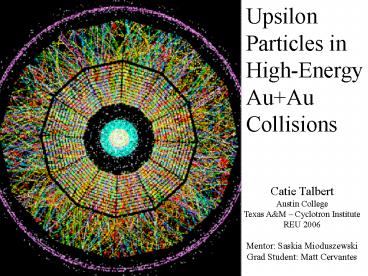Upsilon Particles in HighEnergy Au Au Collisions - PowerPoint PPT Presentation
1 / 17
Title:
Upsilon Particles in HighEnergy Au Au Collisions
Description:
Quarkonium. Meson made up of a quark and its own anti-quark. Charmonium. J/Y (cc) ... In QGP phase, deconfinement, quarkonium no longer bound, charm prefers to ... – PowerPoint PPT presentation
Number of Views:45
Avg rating:3.0/5.0
Title: Upsilon Particles in HighEnergy Au Au Collisions
1
Upsilon Particles in High-Energy AuAu Collisions
Catie Talbert Austin College Texas AM
Cyclotron Institute REU 2006 Mentor Saskia
Mioduszewski Grad Student Matt Cervantes
2
Outline
- Physics Motivation QGP
- Background
- The Accelerator RHIC
- The Detector STAR
- Theoretical/Experimental Approach
- Suppression/Enhancement of J/Y and Upsilon
- STARsim Program
- Summary and Outlook
3
Physics Motivation
- Quarks
- 6 flavors
- Interact in accordance with the strong force
- Exist only in triplets (baryons) or paired with
an anti-quark (mesons) - No free quarks
4
Physics Motivation
- Quark-Gluon Plasma (QGP)
- Phase change that occurs at high energy densities
- Quarks are so densely packed that they no longer
recognize their own boundaries they become
free to move
5
Physics Motivation
- Where can we find QGP?
- Thought to have existed shortly after the Big
Bang - May also exist in (very dense) neutron stars
- Re-create QGP at RHIC
6
The Accelerator RHIC
- Relativistic Heavy-Ion Collider (RHIC)
- 2.4 mile circumference
- 200 GeV (.99995c)
- Gold (Au) ions and protons
7
The Detector STAR
- STAR detector subsystems
- Solenoidal magnet
- Provides for a uniform axial magnetic field
- Time Projection Chamber
- Gives complete 3-D information of the particle
tracks - Electromagnetic Calorimeters
- Provides information on the energy deposited by
e/- and ?
8
STARs Mission
- To re-create the QGP and study the dynamics of
quark matter by observing the particles resulting
from the collisions
9
Theoretical Approach
- Quarkonium
- Meson made up of a quark and its own anti-quark
- Charmonium
- J/Y (cc)
- Bottomonium
- Upsilon (bb)
10
Theoretical Approach
- Suppression of J/Y
- Compared to pp collision (multiplied by of
nucleons) - During initial collision, charm (bottom)
particles are produced - In QGP phase, deconfinement, quarkonium no longer
bound, charm prefers to combine with a light
quark - Suppression of charmonium was thought to be a
signature of the QGP (original idea of Matsui,
Satz)
11
Theoretical Approach
- Enhancement of J/Y
- RHIC has higher energies than previous
experiments - Increased initial charm production
- Increased chance to thermalize
- J/Y can recombine
- Possible increased charmonium count after QGP
phase (Grandchamp, Rapp) - New problem
- Suppression (deconfinement) and
- Enhancement (recombination)
12
Upsilon Particle
- Bottom (Upsilon) is much more rare than charm
(J/Y) - Bottom quark is heavier than charm, takes more
energy to make - Because bottom quark is heavier, difficult to
thermalize ENHANCEMENT not an issue - Only a measure of suppression, disentangles new
Suppression/Enhancement puzzle (Grandchamp, Rapp,
Lumpkins, van Hees, Sun)
13
Experimental Approach
- Importance of STARsim Simulation
- Upsilon is very rare particle, difficult to
measure - We can insert simulated Upsilon particles into
real events and then be able to search for them - This allows for a measure of detector
efficiencies - Simulation allows us to set an upper limit on the
production of Upsilon particles resulting from a
collision
14
Experimental Approach
Experimental Approach
STARsim Program
15
Summary and Outlook
- Goal of RHIC/STAR to create and study QGP
- Because of complications with suppression and
enhancement, Upsilon is important for
understanding J/Y data at RHIC and whether or not
QGP is observed - Simulation is critical for measurement of Upsilon
16
Summary and Outlook
- This summer we got STARsim up and running (!) for
single particle generation - Next step is to embed simulated Upsilon particle
into real data from STAR
17
Acknowledgements
- Dr. Saskia Mioduszewski, Texas AM Cyclotron
Institute - Matt Cervantes, Graduate Student, Texas AM
Cyclotron Institute - STAR Collaboration































